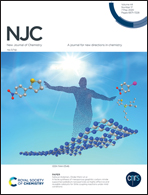Density functional theory study on the donating strength of donor systems in dye-sensitized solar cells†
Abstract
The electron-donating strengths of donor (D) moieties in thirteen donor–π–acceptor systems (D1–π–A to D13–π–A wherein –π– and A represent butadiene and cyanoacrylic acid units, respectively) have been studied using B3LYP/cc-pVDZ level density functional theory (DFT) calculations. The selected D moieties are encountered as a part of an organic sensitizer molecule in dye-sensitized solar cell (DSSC) applications. When the D moiety is joined with π–A, a certain amount of electron donation from D to A occurs leading to an increase in electron density at the A site of D–π–A compared to the A site of π–A. This electron reorganization is quantified in terms of a change in molecular electrostatic potential (MESP) minimum (ΔVmA) at the acceptor site, the CN group of the cyanoacrylic acid. The ΔVmA is always negative, in the range of −11.0 to −2.6 kcal mol−1 which provides a quick assessment of the rank order of the electron-donating nature of the D moieties in the ground state of D–π–A. The optical and photovoltaic properties of D and D–π–A systems are also determined at the TD-CAM-B3LYP/cc-pVDZ//B3LYP/cc-pVDZ level. An absorption red shift (Δλmax) in the range of 81–242 nm is observed when D moieties change to D–π–A systems. The ground state property ΔVmA showed a strong linear correlation with the excited state property Δλmax. Furthermore, ΔVmA is found to be proportional to the open-circuit voltage (VOC). The resemblance of highest occupied molecular orbital (HOMO) and lowest unoccupied molecular orbital (LUMO) energies of the D–π–A system with the respective energies of donor and π–A systems shows that the donor tunes the HOMO, while π–A tunes the LUMO. Among the thirteen D–π–A systems, N,N-dialkylaniline, and julolidine are rated as the best donors for the photovoltaic applications. This study shows that the MESP based assessment of the donating strength of donor systems offers a powerful rational design strategy for the development of efficient dyes for DSSC applications.



 Please wait while we load your content...
Please wait while we load your content...